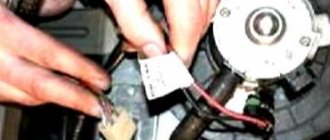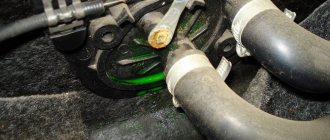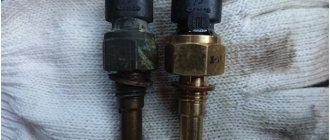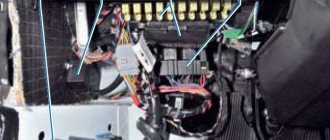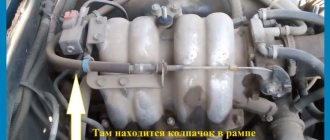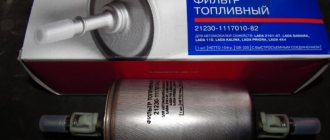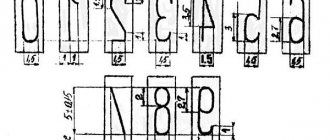What to put in place
Before rushing to the store for a new part, you should first disassemble the assembly and make sure that the faucet is to blame for all the troubles.
It often happens that the seal between it and the heater radiator, where the rubber gaskets are located, leaks. They become limp and begin to leak coolant. The cause of jamming may be the rod attached to the element. For reliability, some VAZ-21213 owners prefer to install a regular plumbing faucet with a diameter of 15 mm (DN 15), connecting it to the stove with flexible pipes. The option is reliable, since plumbing fittings are more durable than car parts. But then it’s better to forget about convenient controls, because every time you have to dive under the glove box on the front passenger side to open or close the valve. It is also installed on the engine side, under the hood, resulting in the same “conveniences”.
Replacing the stove radiator
How to replace a stove tap on a field 21214
The heating system is quite reliable, but like everything that is reliable, it comes to its end. Most often it goes to the pipes and taps; the heater radiator may be the last to leave the distance. Niva VAZ 2121 and its modifications 21213 and 21214 are no exception and problems with the radiator may await them too. Therefore, it is better to prevent a problem than to encounter it in a field on a frosty night.
A sudden cold snap in the Niva’s interior does not mean that something urgently needs to be changed or repaired. For diagnostics, it is not necessary to go to a service station; you can find out everything yourself with a simple set of tools and a head on your shoulders. Actually, the lack of warm air in the air ducts can be the result of several malfunctions:
- air lock in the heating system; clogged air ducts; inoperative or malfunctioning heater motor; clogged heater radiator.
A clogged air intake may come as a complete surprise to the driver. This is especially true for the Niva, which is off-road friendly. Dust, leaves, branches, and other gifts from the forests that are absolutely not needed there can get into the air intake. A faulty heater motor will make itself known immediately, but the radiator will warm up properly, and if it is clogged or leaking, then a replacement is in order.
Before replacing the radiator of the Niva stove, you should think a hundred times whether it needs to be replaced with a new one. It may be better to clean or solder the old one, since a conveyor product is always better than a part from the spare parts stock. Although, it depends on the year of manufacture of the car. In principle, there is no special choice of heater radiators by type - there are only copper and aluminum models. The debate about which one is better will never end, because copper and aluminum are completely different metals with completely different characteristics.
And if we talk about prices, then copper is, of course, more expensive. Its price can be within 2.5 thousand rubles, while an aluminum one will cost no more than 1800. An aluminum heat exchanger has another good ability - it heats up quickly. Perhaps these are all its advantages. The copper part heats up longer, but at the same time:
- retains heat longer; copper has a high thermal inertia; copper is quite elastic and does not crack at the seams as often as aluminum; a copper radiator can always be restored, repaired, cleaned, soldered, but an aluminum radiator cannot.
Changing the heater core is quite simple, although it may take half a day.
That is why we focused on the quality of spare parts, so as not to redo the work several times. All you have to do is stick to the technology, collect all the screwdrivers you have in the garage (preferably with a short blade), be patient and begin a step-by-step replacement:
- Drain the antifreeze from the main radiator and cylinder block, although if the system is sealed, it is enough to close the heater duct. It is better to protect the interior from antifreeze, since some of it will inevitably end up on the floor mats.
- Dismantling the center console, the shelf under the glove compartment and it would be nice to remove the gear shift lever will be in the way. You can remove the lower air duct with it, but it’s more convenient. Unscrew the screws securing the radiator bracket. Loosen or unscrew the screws securing the front panel on the right and left; there is no need to remove the entire panel.
- Remove the rods from the stove tap, dismantle the casing with the fan. Dismantle the heater radiator, first carefully removing the pipes and draining the antifreeze from them.
The new radiator is installed in the reverse order, after which you need to make sure that no air lock has formed in the system. This way you can save at least 2,500 rubles, which would have been charged for this work at the service. And for this money it is better to buy a high-quality radiator that will last another ten years.
Main stove malfunctions
The causes of the malfunction can be listed in a small list:
- A breakdown of the control unit has occurred.
- Mechanical or operational damage to the radiator surface.
- Failed additional resistor.
- Radiator pipes damaged by external factors or worn out by prolonged use.
- Faulty heater valve.
How to determine what kind of breakdown occurred? Let's look at several different signs by which you can determine the cause of the malfunction and understand where to start repairing the stove.
The heater does not heat the footwell
Repairing the stove also does not require great skills in the Chevrolet Niva model. In rare cases, we replace the heater radiator in the Chevrolet Niva model. The Chevrolet Niva heater has a simple device. To fix a breakdown, you must first measure the temperature of the fluid in the system. This action will show where the problem may be. When the engine heats up to 90 degrees without problems, but there is still no heat, then there is a malfunction in the cooling system. The damper should be in good order. Adjust the dampers using the following sequence of actions:
- The engine needs to be heated until you can feel the heat with your open palm.
- The extreme value of the switch is set.
- The knob that regulates the air direction is turned to the upper position, then without delay it must be set to “10” o’clock. These manipulations will help heat get into the bottom of the car.
These steps are repeated until the result is achieved, since this problem mainly arises due to assembly defects. Backlashes prevent the free movement of air and setting the required damper position immediately
It is worth noting that if warm air does not blow inside the car, then you need to pay attention to the cooling system itself. You can also repair the stove in a specialized center for the Chevrolet Niva model
Antifreeze leak from the stove
Wear of rubber hoses, breakdown of the heater valve, all this leads to fluid leakage. Liquid circulation in the system occurs under pressure, which requires one hundred percent tightness of the connections. During use, all connecting tubes and gaskets may become unusable as they lose flexibility and cracks appear. Such breakdowns are usually quite easy to detect. Pipes that have become unusable are replaced. Replacing the stove pipes in a Niva Chevrolet is a fairly easy procedure. The edges of the joints can be coated with sealant before assembly. It is recommended to avoid low-quality, cheap Chinese-made clamps for tightening; they will not provide strong adhesion and tightness of the connections.
The stove does not heat well in the Chevy Niva
Stove repair is not required in new Chevrolet Niva models. The cause of poor performance can be determined after diagnostics. For example, if when changing the air supply force at three speeds you do not notice any changes, or no heat is supplied at all, then most likely the resistor is faulty and needs to be replaced with a working one.
If replacement does not solve the problem, you need to continue diagnosing
If the coolant level drops a day after topping up to the level, you need to pay attention to the condition of the connecting hoses. If necessary, replace with new ones
It is better to fix a breakdown of the heater control unit at a service station, because the specialists working there have the necessary specialized tools needed in this case.
A clogged cabin filter can also cause the stove to stop working. Obstructed circulation increases the load on the vehicle's electrical circuit, thereby leading to blown fuses.
When purchasing a secondary market car, it is recommended to immediately flush the heating system, so as not to have to repair the stove in used Chevrolet Niva models.
Heater diagram
Chevrolet Niva heater valve
The most common reason for its failure is: Warm air does not enter the lower part of the cabin Before starting repairs of the stove, you should check the temperature of the coolant. Perhaps the problem is not in the interior heater, but in the cooling system.
With the help of damper position regulators, warm air is directed to different parts of the cabin. First, the dampers should be adjusted. To supply hot air to your feet, follow these steps: The engine warms up until the warm air can be felt with your hand. Consequently, it is almost impossible to open the tap without breaking it.
Design features of the Chevrolet Niva heater
The vehicle is equipped with a liquid-type heater 12 (Fig. 1), combined with the engine cooling system. Heater radiator 1 (Fig. 2) is placed in a plastic casing installed in the central part of the instrument panel.
A special feature of the heater is the absence of a tap. The heater is controlled by dampers 8 and 13.
The vehicle may be equipped with either a heating and ventilation system or an HVAC system.
These systems are designed to provide the most comfortable conditions for the driver and passengers, regardless of weather conditions.
The heating and ventilation system includes an outside air filter, heater, heater fan, air ducts and deflectors.
Through the air ducts, air from the heater is supplied to the windshield and side window vents, to the central and side vents on the instrument panel, to the vents in the heater casing to supply air to the feet of the driver and passengers, and is also supplied to the feet of rear seat passengers.
The heating and ventilation system is controlled by turning the handles of the control unit, which is installed on the central console of the instrument panel.
The heater housing is located in the center under the instrument panel, and the heater fan housing is located on the right near the A-pillar behind the glove box.
The heating system is liquid, combined with the engine cooling system.
The heater radiator is installed in the instrument panel console in a plastic casing and sealed around the perimeter with foam tape.
Air heating depends on the degree of opening of the valve that regulates the flow of liquid through the radiator. The valve is installed at the radiator inlet and is controlled by the upper lever on the center console.
The fan and heater are connected to each other by intermediate air ducts.
Outside air for interior ventilation when the car is moving enters the car through the air intake slots under the windshield and the outside air purification filter (cabin filter).
To improve air circulation in the cabin, you can lower the door windows when driving, and turn on the electric heater fan at low speed.
In this case, you should move the temperature control knob to the cold (blue) zone, when outside air enters the cabin, bypassing the heater radiator.
Air flows in the cabin are distributed by air ducts, which are located under the instrument panel and under the floor tunnel lining, and under the floor upholstery to supply air to the feet of the rear passengers.
To control the distribution of air flows, use the distribution regulator handle on the center console of the instrument panel, as well as the regulators and guides of the central and side deflectors on the instrument panel.
To heat the interior, move the temperature control knob to the hot (red) zone. In this case, the outside air is directed using a damper through the heater radiator, which is integrated with the engine cooling system.
The heater radiator is installed in a corresponding housing and sealed around the perimeter with foam tape.
The ME-255 fan electric motor is a DC commutator motor, excited by permanent magnets.
The fan speed is controlled by a three-position switch on the instrument panel. Depending on the selected speed, the electric motor is connected to the vehicle’s on-board network directly (high frequency) or through an additional resistor (low frequency). The rotational speed of the electric motor shaft with an impeller at a voltage of 12 V and an air temperature of 25±10°C is 3000±150 min -1. Current consumption at maximum rotation speed is no more than 4.5 A.
The fan impeller is mounted on the electric motor shaft. The electric motor cannot be repaired; if it fails, it must be replaced.
The air is heated by the heat of the engine coolant circulating through the heater radiator tubes.
By turning the temperature control knob, you can change the position of the guide damper, thus adjusting the volume of air passing through the heater core.
The air temperature control knob is located on the center console of the instrument panel.
The intensity of the air supply is determined not only by the degree of opening of the external air supply damper, but also by the rotation speed of the fan impeller, which is changed by turning the fan speed control knob.
The speed control knob is located on the center console of the instrument panel. The fan motor can operate at four different speeds.
The direction of air flows through the cabin is carried out by the air flow distribution handle, which is connected to the dampers by rods.
By controlling the flaps, you can direct air flow through the air ducts to the central and side deflectors on the instrument panel, to the lower vents in the heater casing, as well as to the windshield vents located in the instrument panel.
Some cars are additionally equipped with an air conditioning system, which is designed to reduce the temperature and humidity in the cabin.
The air conditioning system is turned on by pressing the air conditioning switch button located on the instrument panel, and the warning light located in the switch button lights up.
Before turning on the air conditioning system, be sure to turn on the heater fan and move the temperature control knob to the left, to the blue sector
Most of the air conditioning system components are located in the engine compartment. In the car interior there is only an evaporator located under the instrument panel in place of the intermediate air ducts between the heater and its fan.
The evaporator serves for heat exchange between the air entering the vehicle interior and the refrigerant circulating in the air conditioning system.
As it moves through the evaporator tubes, the refrigerant turns into vapor. The process involves the absorption of heat, the evaporator fins are cooled, the cold is removed from the fins and, with the help of the heater fan, is directed into the cabin, helping to lower the internal temperature in the cabin.
The gaseous refrigerant at low pressure flows from the evaporator to the compressor, which increases the pressure of the refrigerant.
The air conditioning compressor is installed on the right side of the engine block under the engine cooling pump.
The compressor is driven by a poly V-belt from the auxiliary drive pulley. An electromagnetic clutch is built into the compressor pulley, which engages and disengages the compressor shaft from the pulley according to signals from the engine control system controller.
Refrigerant vapor from the compressor under high pressure enters the condenser located in front of the radiator of the engine cooling system.
Passing through the honeycombs of the condenser, the refrigerant is cooled by the counter flow of air and with the help of fans of the cooling system. In this case, the refrigerant changes from a gaseous state to a liquid state.
Next, the liquid refrigerant under high pressure enters the receiver, which is fixed under the right headlight in the cavity formed by the right fender, mudguard, front bumper and right bumper mudguard.
The receiver simultaneously performs several functions: as a filter, it cleans the refrigerant from impurities that have entered it; As a dehumidifier, it absorbs moisture condensing inside the air conditioning system and also serves as a reservoir for refrigerant.
From the receiver, the refrigerant enters the reducer located directly on the evaporator.
The reducer is a throttle valve, at the outlet of which the pressure and temperature of the refrigerant are sharply reduced, as a result of which the refrigerant passes from a liquid to a gaseous state.
In this form, the refrigerant again passes through the evaporator, cooling the air entering the vehicle interior. From the evaporator, the refrigerant is again sucked in by the compressor, and the operating cycle is repeated.
Valves are installed on the high and low pressure pipes to charge and release refrigerant from the air conditioning system. A refrigerant pressure sensor is installed on the high pressure pipe.
The pressure sensor sends a signal to the controller, which controls the electric fans of the engine cooling system depending on the refrigerant pressure and vehicle speed.
In addition, based on signals from the pressure sensor, the controller turns off the air conditioning compressor if the refrigerant pressure in the system is too low or high.
There is a shut-off valve installed in the fitting under the pressure sensor, which closes when the sensor is unscrewed, so when replacing the pressure sensor, refrigerant will not leak from the air conditioning system.
The refrigerant in the air conditioning system is mostly under high pressure. When working on depressurization of the air conditioning system, contact with the eyes, skin and respiratory tract should be avoided.
Any work with refrigerant must be carried out only in a ventilated area.
When refilling the air conditioning system, use only materials recommended by the manufacturer.
It is prohibited to carry out welding or soldering work on the components of the air conditioning system.
Repair and maintenance work on the air conditioning system should be carried out by specialized services.
To search for leaks in the system, special equipment is used, and a special contrast agent must be injected into the system. After removing the refrigerant from the system, it is necessary to evacuate the air to remove any remaining moisture. Before refilling the air conditioning system, you must add a special oil recommended by the manufacturer.
Heater diagram
How to replace the heater fan (motor) on a Chevrolet Niva
The most common reason for its failure is: Warm air does not enter the lower part of the cabin Before starting repairs of the stove, you should check the temperature of the coolant. Perhaps the problem is not in the interior heater, but in the cooling system.
With the help of damper position regulators, warm air is directed to different parts of the cabin. First, the dampers should be adjusted. To supply hot air to your feet, follow these steps: The engine warms up until the warm air can be felt with your hand. Consequently, it is almost impossible to open the tap without breaking it.
stove Niva Chevrolet
https://youtube.com/watch?v=UNMCm8ypDbI
To get to it, you need to dismantle the dashboard in the cabin on the passenger side. The stove tap is mounted in a special niche in the engine compartment. If the tap has been replaced, then it is better to install new pipes along with it, because during operation they have probably lost their elasticity.
Collective farm tuning of the Niva Chevrolet stove: In some cases, the correct switching method does not work and then you have to modify the heater in order to achieve its full functionality. The main problem with dampers and ducts is leakage.
We will improve the cracks and eliminate leaks in the stove. Remove the heater control unit by disconnecting all wires and cables from it. If there is a radio, remove that too. Disconnect the transmission tunnel lining.
You don’t have to remove it completely, but only lift it by unscrewing two screws on the driver’s and passenger’s sides. Remove the steering wheel, steering column trim and unscrew the screws securing the front panel. When removing the dashboard, mark all the wires to make it easier to reattach them in their places in the future.
Without removing the entire front panel, when dismantling the heater unit, some elements of the air conditioner and the stove itself can be damaged. Remove the front panel frame attached to the body with screws. The heater housing cannot be removed without dismantling the front panel frame. Behind the frame you will find the heater unit casing, connected to the intermediate housing of the heater or to the evaporator section on a car with air conditioning.
Chevrolet Niva 2012, 80 l. With. — self-repair
Installation of a new unit is carried out in reverse order. The most common purpose of such tuning is to improve the air supply to the driver's and front passenger's footwells. To do this, install additional air ducts and adjust the shape of the damper drive strip
For such modification you will need: You must work with the plastic of the heater housing very carefully, as it is quite fragile
The steps are performed in the following order: Select tubes suitable for the role of additional air ducts. You can use plumbing pipes as additional air ducts. Remove the side trims on the center console on both sides.
Air flows in the cabin are distributed by air ducts, which are located under the instrument panel and under the floor tunnel lining, and under the floor upholstery to supply air to the feet of the rear passengers.
To control the distribution of air flows, use the distribution regulator handle on the center console of the instrument panel, as well as the regulators and guides of the central and side deflectors on the instrument panel.
To heat the interior, move the temperature control knob to the hot red zone. In this case, the outside air is directed using a damper through the heater radiator, which is integrated with the engine cooling system.
Remove the screws of the tie rod brackets. Disconnect the rods from the heater damper levers. Unscrew the screw of the bracket securing the recirculation flap drive rod and remove the lever bracket and disconnect the wiring harness block from the heater electric fan switch.
Heater diagram First of all, we want to orient you that the Niva already has a liquid-type heater installed, which allows you not only to supply warm air into the car interior, but also to cool the running engine, preventing it from overheating. It's no secret that overheating the engine entails extremely undesirable consequences.
An electromagnetic clutch is built into the compressor pulley, which engages and disengages the compressor shaft from the pulley according to signals from the engine control system controller. Refrigerant vapor from the compressor under high pressure enters the condenser located in front of the radiator of the engine cooling system. Passing through the honeycombs of the condenser, the refrigerant is cooled by the counter flow of air and with the help of fans of the cooling system.
Replacing the heater tap of a Niva Chevrolet car with your own hands
The operation of the stove of the Chevrolet Niva car is the object of dissatisfaction among many car enthusiasts. Questions are raised both by the build quality of the heater and the functioning of its individual elements. One of these elements is the coolant valve. Replacing it yourself is not very difficult.
Design and purpose of the heater valve of the Niva Chevrolet car
In a Chevrolet Niva car, coolant can circulate in two cooling circles: summer and winter. The heater tap allows the driver to select one of the circles. If the tap is fully open during the warm season, the interior will be too hot. You will have to open the hood and close the tap, and open it again when cold weather sets in.
Antifreeze in the heating system circulates in two circles
Reasons for replacing a heating tap
In a Chevrolet Niva car, the heater tap is not a serviceable unit. Its repair is impractical for both financial and technical reasons. The only option when a faucet fails is to replace it, the need for which arises in the following cases.
- Internal oxidation of parts. Since the heater valve is in the closed position for a long time during the warm season, its elements can become heavily oxidized and stick to each other. In this case, it is almost impossible to open the tap without breaking it.
- Violation of tightness. The rubbing elements of the faucet wear out over time and can no longer fit tightly to each other. As a result, coolant leaks appear, which can be seen with the naked eye.
: What changes to the Code of Administrative Offenses will affect drivers?
Heating tap location
On a Chevrolet Niva car, the heater tap is mounted in the wall of the engine compartment. If you open the hood of the car, you can see the pipe going from the radiator to the tap adapters.
The heating valve is mounted in a special niche in the engine compartment
To provide access to the crane, it is necessary to disassemble the dashboard on the passenger side of the cabin.
Replacing a heating tap
To work you will need the following tools and consumables:
- new heating tap;
- five-liter container for draining coolant from the radiator;
- set of open-end wrenches;
- set of socket wrenches;
- flat screwdriver;
- pliers.
Sequencing
- A container is installed under the radiator (the best option is a small basin). Then the plug under the radiator is unscrewed and the coolant is drained into the basin. It takes 7–10 minutes to completely drain the coolant.
- The hood of the car opens. The steel hose clamp on the faucet pipe is loosened. To do this, use pliers to carefully bend and remove the short cotter pin. The heating tap clamp is removed using pliers
- The hose is removed from the tap pipe.
- To remove the sealing plate of the faucet, use a 7mm socket wrench to unscrew two self-tapping screws. The self-tapping screws securing the seal are unscrewed with a 7 mm socket wrench.
- The sealing plate is removed. After unscrewing the screws, the sealing plate can be removed from the tap manually
- Use a key number 8 to unscrew the fastenings of the glove compartment in the cabin. After removing the glove compartment, access to the heater valve opens.
- A rod is attached to the crane lever using a clamping bracket.
Use an open-end wrench size 7 to loosen the nut located on the bracket. The traction cable is removed from the crane lever. Use an open-end wrench to loosen the tie rod - Use a 10mm socket to unscrew the two bolts securing the faucet to the wall of the engine compartment. The heating tap mounting bolts are unscrewed with a 10 mm socket wrench.
- The heater tap is removed from its niche and replaced with a new one.
The heating tap is removed from its seat
Assembly and installation of the crane is carried out in the reverse order.
Useful tips
There are a number of points to consider when replacing a heating tap.
- It is quite difficult to find an original faucet for sale for a Chevrolet Niva car that is not of high quality.
- Most car owners install cranes manufactured by LUZAR. At the same time, preference is given not to metal, but to ceramic products, which are considered more reliable. The cost of such a crane ranges from 500 to 900 rubles. The heater valve produced by LUZAR is considered the most reliable
- In exceptional cases, it is possible to install a three-way sanitary tap DN15 in place of the heating tap. Its internal flow diameter is 15 mm - this is enough for normal circulation of antifreeze. However, due to design features, it is impossible to attach a rod to the DN15 tap, which allows you to change the coolant circulation circles directly from the car interior. Therefore, to change the heating mode you will have to open the hood. In exceptional cases, you can use a DN15 sanitary tap
- It is recommended to apply a thin layer of high temperature sealant to the sealing plate prior to installation. This will greatly reduce the risk of coolant leakage. High-quality sealants are produced by ABRO. The cost of one tube, depending on the volume, ranges from 300 to 500 rubles. ABRO high temperature sealant will reduce the risk of coolant leakage
- You need to remove the fastening pin on the faucet clamp very carefully, as it is quite fragile. If removed carelessly, a piece of the cotter pin may get stuck in the clamp . It won't be easy to get him out of there.
: Car fire extinguisher
Thus, replacing the interior heating system tap on a Chevrolet Niva car is quite simple. Even an inexperienced car enthusiast can do this with a standard set of tools and one hour of free time.
Copywriter with five years of experience. (2 votes, 1 out of 5)
Source: https://auto-gl.ru/zamena-krana-otopitelya-avtomobilya-niva-shevrole-svoimi-rukami/
Refinement of the heating system of the Chevrolet Niva
When the intensity of supply of air heated by the heater into the cabin decreases, it becomes necessary to modify the heating system. This is due to errors in the assembly of the system. The main problem is the lack of tightness in the air ducts and dampers. This leads to incorrect distribution of warm air throughout the cabin. The modification is carried out as follows.
- The steering column casing and driver's side console are removed.
- On the heater side, a plate is removed that sets the direction of air supply.
The die located on the heater side needs improvement
- The slot at the top of the die is made straight while maintaining the starting and ending points. To give the desired trajectory of movement of the damper, you can glue a plastic card to the die.
To give the desired trajectory of movement of the damper, you can glue a plastic card to the die
- The lower flap, which is responsible for supplying air to the legs, is rigidly attached. To do this, a homemade bracket is cut out.
The last stage of modification of the stove is the rigid fixation of the lower damper
As a result, warm air will be distributed throughout the cabin strictly in accordance with the position of the flow direction regulator.
Thus, even an inexperienced car enthusiast can ensure a comfortable microclimate in the interior of a Chevrolet Niva car. To do this, you just need to strictly follow the instructions and recommendations of professionals.
Do-it-yourself conversion of the stove on Niva 21213
CAUSE
REMEDY METHOD
The operation of the stove on the classic Niva traditionally causes complaints from most owners of this car. A frankly weak but noisy fan and poor design of the air ducts do not warm the interior properly. In addition, the operation of the heater is affected by the operation of the VAZ 2121, 2131 in difficult road conditions.
Read news about the new Niva
- How to connect fog lights via a relay and a button: diagram
- Review of the standard alarm system Niva Chevrolet
- DIY stove conversion in Niva 21213
- Replacing a Chevrolet Niva heater radiator with air conditioning without removing the panel
- Relays and fuses Lada 4×4 (VAZ 21214, 21314) » Lada.Online || Niva 21213 low beam power button
- How to use a transfer case in a field, box design || Switching the transfer case in the field from a button
- How to change the light bulbs on the instrument panel of a Niva Chevrolet: video
- How to use locks and lowering correctly. Niva and differential lock
| Wires are damaged or wire connections are oxidized | Check and restore connections. Replace damaged wires |
| Fuse 1 in the fuse block has blown | Replace the fuse |
| The heater switch is damaged - no voltage is supplied to the switch output terminals | Check the switch, replace it with a new one if necessary |
| Sticking or wear of the motor brushes, a break in the armature winding or contamination of the commutator | Check motor, repair or replace |
| Short circuit to ground in the armature winding - when the electric motor is turned on, the fuse burns out | Replace the motor |
| Wires are damaged or wire connections are oxidized | Replace damaged wires, strip wire ends |
| Damaged heater switch | Replace the switch |
| Additional resistor burnt out | Replace the resistor |
| Additional resistor burnt out | Clean the commutator, replace the brushes |
| Contamination or oxidation of the commutator, worn brushes | Replace the motor |
| Interturn short circuit in the armature winding | Disassemble the electric motor, clean the shaft journals |
Where is the heater tap on a Chevrolet Niva?
Most motorists today are dissatisfied with the operation of the stove on the Chevrolet Niva. There are many complaints: from the build quality of the device to the unsatisfactory functioning of certain parts, one of which is the stove tap. This element can be replaced even in a garage.
Improvement No. 3. Installing the grille on the air intake
When disassembling the heater, a large number of tree leaves and insect remains were found in the air intake casing and in the honeycombs of the heater radiator grille, which also reduced the efficiency of the heater. Therefore, after cleaning and flushing the heater core, I took measures to prevent the radiator from clogging.
To do this, I bent a wire frame to the size of the air intake inlet, covered it with a nylon mesh with a 1x1 mm cell, and installed it at the bottom of the rubber seal of the air intake inlet. It was perfectly fixed there in the fold, like an accordion, without additional fastening.
All work to modify the heater took me about 4 hours of time and did not cost a penny of additional costs. Unfortunately, during work I didn’t think to take a photo, but from the attached drawing and picture everything should be clear. I'm happy with the result, now the stove heats better.
Keywords: stove 4x4 | 4x4 air ducts
13
4
Found an error? Select it and press Ctrl+Enter..
Why do you need to change the faucet?
In Niva cars, as in classic Zhiguli models, the heating intensity of the interior is controlled using a special tap. It is installed on the coolant supply pipe leading to the heater radiator. The stove tap is made in such a way as to open and shut off the flow in just half a turn of the rod. Thanks to this, the faucet can be controlled using a rod attached to a lever on the center console.
In reality, no one uses the heater valve as a regulator; more often it is used to cut off the heater from the Niva engine in the summer. This is where the following problems arise:
If you do not shut off the fluid flow in the summer, then the interior of the VAZ-21213 will become very hot. In the Chevrolet Niva, the faucet is missing as a weak link, and the stove is constantly heating up. The design of a regular Niva is not designed for this and the problem needs to be solved somehow.
The situation is the same in the other two cases, and due to a leak, harmful antifreeze vapors will accumulate inside the car. Since the design of the heater valve does not provide for its repair, the part only needs to be replaced.
Procedure for installing a new part
Due to the fact that the heater radiator is located above the engine, part of the coolant does not flow out of it when it is emptied. And even more so it is full when the old tap is stuck closed. So before disassembling the unit, you need to stock up on a plastic bag without holes: it is convenient to place it in places with limited access.
Disassembly and removal of the tap are carried out in the following order:
- From the engine compartment, you need to loosen the clamps of the pipes leading into the cabin, and then remove them from the fittings.
- Unscrew the screws holding the sealing gasket (key 8) and remove it.
- From the interior of the Niva, you need to get to the tap and disconnect the rod by unscrewing the clamping bolt (key 7). Place a plastic bag to catch the remaining antifreeze.
- Loosen the bolts securing the faucet to the stove (key 10), unscrew them and pull out the part along with the metal pipe. If the heater radiator is copper, of the old type, then instead of bolts there will be nuts.
- Separate the metal pipe from the old faucet by unscrewing 2 nuts (10 wrench). Remove the traction mount from it.
Taking this opportunity, it wouldn’t hurt to check the tightness of the connection of the second pipe to the radiator and, if necessary, change the gaskets there. It is also recommended to install new clamps on the hoses.
To avoid air locks when filling the system with liquid, you need to fill it slowly until antifreeze flows from the carburetor heating pipe. In this case, the heater valve must be open.
When disassembling the heater, a large number of tree leaves and insect remains were found in the air intake casing and in the honeycombs of the heater radiator grille, which also reduced the efficiency of the heater. Therefore, after cleaning and flushing the heater core, I took measures to prevent the radiator from clogging.
To do this, I bent a wire frame to the size of the air intake inlet, covered it with a nylon mesh with a 1x1 mm cell, and installed it at the bottom of the rubber seal of the air intake inlet. It was perfectly fixed there in the fold, like an accordion, without additional fastening.
Fan replacement
Experienced car owners recommend not stopping there and continuing to modify the stove by tuning the fan.
Some people suggest getting rid of the fan installed by the manufacturer and installing a figure eight fan instead.
If you also decide to carry out such a replacement, you need to additionally decide whether you will leave the original control of the stove or also replace it with a “eight” analogue.
Having decided on the second option, take care of purchasing the following additional items:
- fan speed switch;
- additional resistor for the stove.
So, after you have completely prepared all the necessary components, you can proceed directly to the process of modifying the fan.
Initially, you should dismantle the old air supply box. Unfortunately, despite the fact that this requires unscrewing only four nuts, it will not be possible to do this without outside help. Your partner will need to hold the screws under the hood while you unscrew them using a wrench.
After this, you can easily remove the air intake. Clean it if it needs it, and then cut away a small amount of the plastic to provide enough space for the new fan to operate.
Install the fan and carefully inspect for anything that may interfere with the operation of the installed fan. If you find such obstacles, carefully cut them off.
Once you are sure that there is nothing else that can prevent the fan from working, secure it with sealant. There are small gaps around the fan nozzle; it is important to eliminate them by covering them with any material. This will prevent warm air from escaping.
Now the assembled fan is being introduced back into the space in which its old counterpart previously “lived”. Everything is securely fastened and the closing and opening of the hood is checked. In some cases, after the introduction of a “foreign” fan, it is not possible to close the hood normally.
If everything is fine, reconnect all wires and install new controls. Upon completion of the work, be sure to check your results in action.
The stove should work perfectly, and warm air should spread very quickly inside the car.
Faucet replacement process
Those car owners who have an amazingly developed engineering sense, and whom nature has endowed with design abilities, immediately notice that the weak link in the Chevrolet Niva heating system is the fan. They are also particularly unhappy with the design of the air ducts. It is for this reason that it is initially recommended to modernize these two components. Those who have already walked this path argue that it is completely unreasonable to stop at the achieved result, since, in addition, even the stove faucet is unable to do its job as efficiently as possible. The reason for this is its small internal cross-section. In such a narrow space, the coolant cannot move quickly, and accordingly, it is impossible to count on quickly heating the interior. It’s even worse when the heating becomes ineffective due to the failure of this tap. In this case, it becomes necessary to carry out certain repair work, during which many people have a question about how to replace the heater tap on Niva 21214. We will help you understand this issue.
Read more: Audi 80 carburetor conversion
Replacement algorithm
So, if you have a critical situation in which the stove faucet needs to be replaced, you will, of course, first need to decide which faucet is most suitable for you in this case. Experienced craftsmen recommend giving preference to cranes from foreign cars. They benefit from a longer service life as well as high operating efficiency.
By the way, if you want to minimize your financial expenses, and also not subject yourself to labor-intensive actions in the future, it is best to pay attention to cranes from budget Volkswagen or Opel models. So, after you have not only decided, but have already purchased the desired replacement option, you can begin to take immediate action.
Initially, you should disconnect the hose from the pipe. This action is quite difficult, since the hose sits tightly on the pipe. If you move incorrectly, your hand may slip and you may be injured. For this reason, we recommend that you wear gloves to avoid such unfortunate consequences.
Now, using a screwdriver, unscrew the screws that secure the seal, pressing it against the partition. After removing the screws, lightly pick up the seal and remove it completely. It will be more convenient for you to carry out the following steps from inside the car; they consist in the fact that you need to loosen the clamping screw of the faucet using an open-end wrench.
Next, remove the cable from the faucet lever. All that remains is to unscrew the fixing elements holding the radiator. They can be either screws or nuts. Now you can remove the tap; all that remains is to remove the pipe, freeing it from the fixing nuts.
Now the work ahead is to install a new crane. All actions are performed in exactly the same way, only in reverse order. We recommend that you use a little trick when attaching the radiator. Simply tightened nuts fall out almost instantly. To avoid this, take plasticine, place nuts on it and tighten them. When assembling, be careful with the cable. You cannot reduce its length, otherwise it will be difficult to perform some actions with the stove, in particular, adjusting the temperature or speed of the warm air flow.
So, don't be afraid to do some things yourself to improve the performance of certain parts of your vehicle. If you strictly follow our recommendations, you will be able to enjoy the results achieved.
Preparatory stage
To change the heater tap, you need to perform 2 preliminary operations: partially drain the coolant and remove the glove box.
Antifreeze is drained in the following sequence:
- The operation is carried out on a cooled engine to avoid burns. Under the engine on the left side (in the direction of movement) you need to place a basin or a cut plastic canister.
- Fully open the stove tap (if possible).
- Having prepared a 1 m long hose, unscrew the plug on the cylinder block (key 13), move it to the side and place the hose directed into the basin.
- Hold the hose and smoothly open the expansion tank cap. Be careful as the antifreeze stream will become larger.
- Loosen the clamp of the carburetor heating pipe or the injector throttle valve block and remove it from the fitting.
- When the fluid has drained, screw the plug back into the block and tighten.
Why do you need to change the faucet?
In Niva cars, as in classic Zhiguli models, the heating intensity of the interior is controlled using a special tap. It is installed on the coolant supply pipe leading to the heater radiator. The stove tap is made in such a way as to open and shut off the flow in just half a turn of the rod. Thanks to this, the faucet can be controlled using a rod attached to a lever on the center console.
In reality, no one uses the heater valve as a regulator; more often it is used to cut off the heater from the Niva engine in the summer. This is where the following problems arise:
- the faucet jams in one position, it is impossible to close it;
- after a warm period, the tap turns sour and does not want to open;
- the part begins to leak at any time of the year.
If you do not shut off the fluid flow in the summer, then the interior of the VAZ-21213 will become very hot. In the Chevrolet Niva, the faucet is missing as a weak link, and the stove is constantly heating up. The design of a regular Niva is not designed for this and the problem needs to be solved somehow.
The situation is the same in the other two cases, and due to a leak, harmful antifreeze vapors will accumulate inside the car. Since the design of the heater valve does not provide for its repair, the part only needs to be replaced.
Where is the heater valve located on a Chevrolet Niva - Automaster
Most motorists today are dissatisfied with the operation of the stove on the Chevrolet Niva. There are many complaints: from the build quality of the device to the unsatisfactory functioning of certain parts, one of which is the stove tap. This element can be replaced even in a garage.
Replacing the heater tap of a Niva Chevrolet car with your own hands
The operation of the stove of the Chevrolet Niva car is the object of dissatisfaction among many car enthusiasts. Questions are raised both by the build quality of the heater and the functioning of its individual elements. One of these elements is the coolant valve. Replacing it yourself is not very difficult.
In a Chevrolet Niva car, coolant can circulate in two cooling circles: summer and winter. The heater tap allows the driver to select one of the circles. If the tap is fully open during the warm season, the interior will be too hot. You will have to open the hood and close the tap, and open it again when cold weather sets in.
Antifreeze in the heating system circulates in two circles
Procedure for installing a new part
Due to the fact that the heater radiator is located above the engine, part of the coolant does not flow out of it when it is emptied. And even more so it is full when the old tap is stuck closed. So before disassembling the unit, you need to stock up on a plastic bag without holes: it is convenient to place it in places with limited access.
Also interesting: Rating of winter tires for Chevrolet Niva
Disassembly and removal of the tap are carried out in the following order:
- From the engine compartment, you need to loosen the clamps of the pipes leading into the cabin, and then remove them from the fittings.
- Unscrew the screws holding the sealing gasket (key 8) and remove it.
- From the interior of the Niva, you need to get to the tap and disconnect the rod by unscrewing the clamping bolt (key 7). Place a plastic bag to catch the remaining antifreeze.
- Loosen the bolts securing the faucet to the stove (key 10), unscrew them and pull out the part along with the metal pipe. If the heater radiator is copper, of the old type, then instead of bolts there will be nuts.
- Separate the metal pipe from the old faucet by unscrewing 2 nuts (10 wrench). Remove the traction mount from it.
Taking this opportunity, it wouldn’t hurt to check the tightness of the connection of the second pipe to the radiator and, if necessary, change the gaskets there. It is also recommended to install new clamps on the hoses.
To avoid air locks when filling the system with liquid, you need to fill it slowly until antifreeze flows from the carburetor heating pipe. In this case, the heater valve must be open.
When disassembling the heater, a large number of tree leaves and insect remains were found in the air intake casing and in the honeycombs of the heater radiator grille, which also reduced the efficiency of the heater. Therefore, after cleaning and flushing the heater core, I took measures to prevent the radiator from clogging.
To do this, I bent a wire frame to the size of the air intake inlet, covered it with a nylon mesh with a 1x1 mm cell, and installed it at the bottom of the rubber seal of the air intake inlet. It was perfectly fixed there in the fold, like an accordion, without additional fastening.
Chevrolet Niva heater tap: where it is, how to replace it + video » AutoNovator - Auto site
Lack of voltage on the electric motor due to poor contact. Visible damage to the motor wires due to chafing. Failure of the fan fuse at 25 Replacing the heater tap of the Niva Chevrolet video, located in the fuse block under number F. Failure of one of the resistors, manifested in the absence of one of the speed modes.
Deterioration of the armature and brushes of an electric motor as a result of long-term continuous operation. If the electric motor malfunctions, it will need to be removed. In any of the above situations, the electric motor will need to be removed.
How to change the heater tap on a Chevrolet Niva
Heating system fan repair To diagnose a malfunction, the electric motor is connected directly to the battery. Heater valve on Replacing heater valve Niva Chevrolet video If it works, the problem should be looked for elsewhere. Otherwise, the electric motor is removed for repair or replacement. My account It is located under the glove compartment panel in the cabin. After dismantling, the electric motor is disassembled and inspected.
The heater electric motor may not work due to internal contamination. The design of the electric motor is quite simple. The reason for its stopping may be contamination, wear-out of the armature, bushings or brushes.
The reason for the failure of the electric motor may be the replacement of the heater valve, brushes or armature. The electric motor is cleaned and installed in place or replaced with a new one.
Repair of the stove radiator The main signs of a malfunction of the stove radiator are as follows: Coolant leakage from the stove radiator must be repaired immediately. If any of the signs are detected, the stove is diagnosed, based on the results of which a decision is made to repair or replace the radiator.
More often, car owners install a new radiator. In this case, the system is completely freed from coolant. When a heater radiator fails, it is usually replaced. Replacing a radiator on a car with air conditioning is a rather complex process that requires special equipment and appropriate skills. The fact is that in the summer the tap is closed, and its elements stick to each other. This is true when purchasing and operating used cars. However, replacing the heater valve Niva Chevrolet video can sometimes fail.
Replacing the heater cable Sometimes it is not possible to change the position of the heater damper. The reason for this is a broken cable. To replace it, you will need a standard set of tools and a headlamp.
Replacing the cable is carried out as follows. The driver's seat moves back. The handles are removed from the damper control panel and the screws are unscrewed.
The panel is dismantled on the left side at the location of the driver's feet. To access the cable, you will need to remove the heater control mechanism. The latches securing the cables are removed.
The recirculation damper mechanism is dismantled and the cable is removed. A new cable is installed.
Each end must be twisted into a ring and securely fixed. Using a cable, the position of the air supply flap is changed. Assembly is carried out in the reverse order. The functionality of the mechanism is checked. Replacing the interior heating control unit A faulty control unit can also cause incorrect operation of the interior heating system.
Its dismantling, necessary for repair or replacement, requires the following procedure. The negative terminal is disconnected from the battery. All handles are removed from the heater control mechanism.
To do this, they need to be carefully pulled to replace the heater valve Niva Chevrolet video. All handles are removed from the heater control mechanism. Use a flat screwdriver to remove the air circulation lever. Use a flat screwdriver to remove the air circulation lever. Use a screwdriver to pry up and then remove the block lining.
Use a screwdriver to pry up and then remove the block lining. Under the lining, use a Phillips screwdriver to unscrew the self-tapping screw. Under the cladding, two self-tapping screws are unscrewed. The control unit is removed. Remove the connector with the wires going to the speed switch. The block of wires that provide illumination of the unit is disconnected. The connector with wires is removed from the control unit. If there is an air conditioner, all hoses coming from the vacuum switch are disconnected.
Use a screwdriver to remove the bracket holding the damper cable braid and other similar elements. All rods are disconnected from the control unit. A new or repaired device is installed in the reverse order. After dismantling, the control unit is repaired or replaced with a new one. Replacing the stove pipes If a coolant leak is detected, the pipes along with the clamps should be replaced.
Where is the heater valve on a Chevrolet Niva?
The work is performed in the following sequence: The coolant is drained from the system. The screws securing the glove compartment are unscrewed and it is removed. Use a Phillips screwdriver to unscrew the clamp of the lower pipe. The hose is removed carefully - the antifreeze should not get on exposed skin. If difficulties arise, the pipe should be rotated around its axis. The second pipe is removed in the same way.
New hoses are installed and tightened with clamps. If antifreeze leaks, the heater pipes are replaced with new ones: Before removing the heater electric motor, you need to make sure that it is faulty. The most common reasons for its failure are: Lack of voltage on the electric motor due to poor contact.
Visible damage to the motor wires due to chafing. Failure of the 25 A fan fuse, located in the fuse block under number F. Failure of one of the resistors, manifested in the absence of one of the speed modes. No ignition. Deterioration of the armature and brushes of an electric motor as a result of long-term continuous operation.
If the electric motor malfunctions, it will need to be dismantled. In the above situations, the electric motor will need to be removed.
Heating system fan repair To diagnose a malfunction, the electric motor is connected directly to the battery. If it works, the problem should be looked for elsewhere. Otherwise, the electric motor is removed for repair or replacement. It is located under the glove compartment panel in the cabin.
